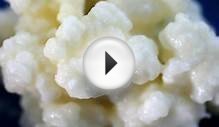

What is Water Kefir?
Water kefir is a probiotic, fermented beverage that can be flavored with a variety of juices. Some people drink it as a healthy alternative to soda.
Making water kefir has a definite cool factor to it.
- It is not as well known as milk kefir. So, most people say, “Whoa – what’s that?” – Thus giving you a chance to spread the word.
- Others have heard of it, but not tried it themselves so you become the expert to tell them how fabulously easy it is. (And it is very easy!)
- When you mention it to people “in the know”, you are seen as a true fermenter who is taking control of your health in a fun, creative way. They get where you are coming from.
So Here’s Some Basic Info:
- Kefir is made with kefir “grains”, but they are not in any way related to grains like wheat. They are really a combination of yeast and bacteria in a symbiotic relationship. (Translation: They rely on each other to live and multiply.) They are called “grains” due to their shape.
- The grains turn sugar into lactic acid, carbon dioxide and sometimes a tiny bit of alcohol (less than 1%) and the good bacteria multiply like crazy creating a very nutritious, probiotic beverage.
 In fact, it has a much higher concentration of probiotics than yogurt and store-bought milk kefir.
In fact, it has a much higher concentration of probiotics than yogurt and store-bought milk kefir. - Although kefir is very different from Kombucha (a fermented tea that is also made from a combination of yeast and bacteria) there are similar chemical processes going on.
- Yes it is made with sugar water, but because the grains consume much of the sugar, the resulting beverage is actually fairly low in sugar. The longer you ferment, the less sugar you have left.
- Once fermented, water kefir can be consumed straight or flavored with any combination of juices.
- You can also give it a second ferment and create carbonation, which essentially makes it taste like custom soda.
- Kefir grains are living things. They are fed by the sugar water and give back the probiotic benefits.
- It is easily made at room temperature on your kitchen counter.
- The grains are reusable – meaning that you can reuse them from batch to batch without ever having to buy more.
So let’s get started…
How is it Pronounced?
There is no right or wrong way to say kefir.
Some people say ka-fear and others say key-fur. Personally, I say the later because that is how most people around me pronounce it. But really…who cares as long as it tastes good?!
 Say it however you want.
Say it however you want.
Water Kefir vs. Milk Kefir
Milk kefir might be more familiar to you. It is made from animal milk (cow, goat, etc.) or from milk alternatives such as coconut milk. You can also find it in the grocery store, though store-bought versions are not as beneficial as homemade.
Milk and water kefir use different grains but they are fermented in a similar way.
However, water kefir:
- Is dairy free
- Can be made from sugar water, fruit juice or coconut milk
- Is easy to flavor in unlimited ways
- Is easier than milk kefir to consume in larger quantities
What Water Should You Use?
Your water must be free from chlorine and fluoride because both can kill or hinder the yeast and bacteria in the grains.
Filtered water is good, but might lack some minerals and kefir grains love minerals. (I use filtered water)
Here are your options:
- Filtered or bottled water: Will work well. You can add mineral drops to the water if you want to keep the grains in peak condition but it is not absolutely necessary. I made kefir water for years without drops and all was still right with the world. I do use them now. You can also occasionally use a spoonful of molasses to add some minerals.
- Tap water : Will probably have chlorine and other chemicals, so treat it first. You can boil the chlorine out, use a blender to aerate it out or let it set on the counter for 12 hours so the chlorine evaporates.
- Well water: is great for kefir and full of minerals
- Coconut water: is another great choice. It gives you more benefits and avoids any chemicals that might be in regular water. (I will cover this in another post)
 What Sugar Should You Use?
What Sugar Should You Use?
There are many choices. Standard white sugar offers the least amount of nutrition to the grains. I alternate between organic raw, cane sugar and sucanat. I alternate because I don’t always have sucanat on hand and it is more expensive.
I list all the options below.
The only sugar you cannot use is honey because it is hard on the grains and may kill most of the bacteria. (Honey is not nutritious for the grains and is antibacterial) Technically, you can use honey occasionally and then refresh the grains with several batches of other sugar to get them going again. But you cannot use honey on a regular basis and still reuse the grains. Most people avoid honey all together.
Keep in mind that if your sugar water or juice has a color, the grains will take on the color also. This is not a problem – I just want you to be aware.
Your choices include:
- Organic Raw Cane Sugar
- Sucanat and Rapadura – both are whole unrefined cane sugars. They are darker in color. Of the two, rapadura is processed less and the molasses is never removed from the product whereas the molasses is removed and then blended back in with sucanat.
- Molasses – a by-product of sugar production where much of the minerals are still present. Some people combine cane sugar with a spoonful of molasses to get a more well rounded sugar.
- Fruit Juice: Some people use straight organic juice because it has natural sugars.
 Although it may have different fermentation times based on the sweetness of the fruit, it works just fine.
Although it may have different fermentation times based on the sweetness of the fruit, it works just fine. - Processed white cane sugar: Yes, you can use it. No, it is not the best for the grains. But I do understand that sometimes you just have to use it in a pinch. Try not to use it all the time as there is better nutrition in the other sugars listed above.
Step-by-Step Instructions for Water Kefir:
Making water kefir is not an exact process. Everyone has a little bit different method and timing that they prefer. It is okay to experiment with timing and flavorings. I have outlined below how I do it and I noted in a few places where people do it differently. When touching the grains, always use glass, plastic or wooden tools and utensils. Some metals can hinder the grains.
Important Note: If you have never had water kefir before or if you do not regularly eat foods high in probiotic bacteria, you need to ease into drinking this or you may get an upset stomach or other not so fun reaction. I would suggest starting with just a spoonful or two each day for several days and then slowly add more until you can drink a glass. No reason to shock your system!
You will need:
- A clean, quart-sized jar
- 1/4 cup sugar (whichever kind you choose from the list above)
- 3-4 cups water
- 3-4 Tbsp. plump, reconstituted water kefir grains (see note)
- Paper coffee filter
- Rubber band or canning jar ring
Note: You must buy the grains or get some from friend who has extra (They multiply like crazy!). If you buy dehydrated grains, follow the instructions on the box to revive them. It usually means letting them ferment for 3-5 days the first round. After that, start at step 1 below.
YOU MIGHT ALSO LIKE












